The Moonlight Sonata, composed by Ludwig van Beethoven in 1801, is a timeless piano masterpiece. Its dreamy, evocative first movement has captivated audiences worldwide, making it one of the most recognizable classical pieces. Originally titled Piano Sonata No. 14 in C-sharp minor, Op. 27, No. 2, it earned its nickname from a poet’s description of the music resembling moonlight on water. This sonata, divided into three movements, showcases Beethoven’s innovative approach to musical expression. Today, it remains a beloved piece for pianists and music enthusiasts, with free sheet music readily available in PDF format for those eager to explore its beauty.
1.1 Overview of the Moonlight Sonata
The Moonlight Sonata, officially titled Piano Sonata No. 14 in C-sharp minor, Op. 27, No. 2, is one of Beethoven’s most renowned compositions. Completed in 1801, it is celebrated for its dreamy, introspective quality, particularly in the first movement. The sonata consists of three movements: Adagio sostenuto, Allegretto, and Presto agitato. Its popularity stems from its technical complexity and emotional depth, making it a favorite among pianists and music enthusiasts. The sonata’s nickname, Moonlight, was coined by the German music critic and pianist Ludwig Rellstab, who likened the first movement to the shimmering light of the moon on water. This piece remains a cornerstone of classical music, with its sheet music widely sought after for both study and performance.
1.2 Popularity and Cultural Significance
The Moonlight Sonata is one of Beethoven’s most iconic works, enduring in popularity for over two centuries. Its haunting beauty and emotional depth have captivated audiences worldwide, making it a cultural phenomenon. The piece frequently appears in films, advertisements, and media, enhancing its widespread appeal. Its association with romance and introspection has solidified its place in popular culture. The sonata’s technical complexity and expressive qualities continue to inspire pianists and composers alike, ensuring its lasting relevance in both classical and contemporary contexts. Its influence extends beyond music, symbolizing artistic excellence and emotional resonance.
1.3 Brief History of the Composition
The Moonlight Sonata was composed by Ludwig van Beethoven in 1801 and published in 1802. It is officially known as Piano Sonata No. 14 in C-sharp minor, Op. 27, No. 2. Beethoven dedicated the piece to his pupil, Countess Julia Guicciardi. The name “Moonlight” was coined by the German music critic Ludwig Rellstab, who likened the sonata’s dreamy, introspective quality to moonlight shining on Lake Lucerne. This sonata marked a turning point in Beethoven’s career, showcasing his innovative approach to musical expression and emotional depth. Its composition occurred during a period of personal struggle, including the onset of his hearing loss, yet it remains a testament to his genius.
Structure and Movements of the Moonlight Sonata
The Moonlight Sonata consists of three movements: Adagio Sostenuto, Allegretto, and Presto Agitato, each showcasing Beethoven’s mastery of emotional depth and technical complexity.
2.1 First Movement: Adagio Sostenuto
The first movement of the Moonlight Sonata, marked Adagio Sostenuto, is one of Beethoven’s most recognizable compositions. It begins with a dreamy, introspective melody played in arpeggiotic triplets, creating a hauntingly beautiful atmosphere. The movement is written in C-sharp minor and features a steady, flowing rhythm that underscores its emotional depth. Pianists must carefully balance dynamics and pedaling to maintain the piece’s ethereal quality. This movement’s soothing yet profound nature has made it a favorite among both performers and audiences worldwide.
2.2 Second Movement: Allegretto
The second movement, marked Allegretto, offers a stark contrast to the first, with a lively and graceful scherzo-like character. Written in D-flat major, it features a bright, almost playful theme that moves with a moderate tempo. The movement follows a ternary form, with a central trio section that introduces a more lyrical melody. Pianists must maintain a delicate balance between the light, dancing rhythms and the underlying harmonic richness. This movement serves as a refreshing interlude, bridging the dramatic first and third movements with its buoyant energy and charm.
2.3 Third Movement: Presto Agitato
The third movement, Presto Agitato, is a dramatic and intense finale, written in C-sharp minor. It is known for its relentless energy and technical demands, featuring rapid arpeggios and sharp dynamic contrasts. The movement follows a sonata-rondo form, with recurring themes that build tension and complexity. Pianists must master precise finger dexterity and control to navigate the intricate passages. The Presto Agitato is a thrilling conclusion to the sonata, showcasing Beethoven’s mastery of dramatic expression and technical brilliance, leaving a lasting emotional impact on listeners.
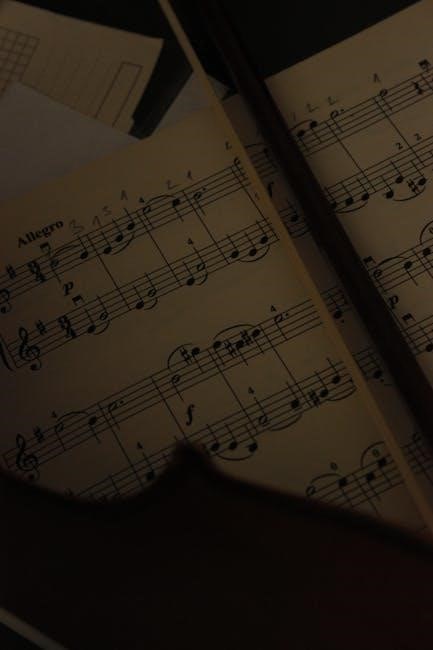
Key Features of the Moonlight Sonata
The Moonlight Sonata is renowned for its dreamy, introspective Adagio Sostenuto, technical challenges in the Presto Agitato, and profound emotional depth, showcasing Beethoven’s innovative genius.
3.1 Musical Characteristics
The Moonlight Sonata is characterized by its flowing arpeggios, dramatic contrasts, and emotional intensity. The first movement features a lyrical, dreamy quality with a somber mood, while the second movement is lively and playful. The third movement is a virtuosic presto with rapid arpeggios and dramatic dynamics. Beethoven’s use of tonality, particularly in the keys of C-sharp minor and D-flat major, creates a sense of tension and resolution. The sonata’s structure and harmonic innovations were groundbreaking for its time, showcasing Beethoven’s mastery of musical expression.
3.2 Emotional Depth and Expression
The Moonlight Sonata is renowned for its profound emotional depth, capturing a wide range of feelings from tranquility to turmoil. The first movement’s haunting melody evokes a sense of introspection and calm, while the third movement’s dramatic intensity conveys urgency and passion; Beethoven’s mastery of dynamics, tempo, and harmonic shifts creates a compelling narrative, drawing listeners into an emotional journey. The sonata’s ability to express complex human emotions has made it a timeless and deeply personal work, resonating with audiences for centuries.
3.4 Technical Challenges for Pianists
The Moonlight Sonata presents significant technical challenges, particularly in its demanding passages and intricate fingerwork. The first movement requires precise control over delicate arpeggios, while the third movement’s rapid tempo demands exceptional dexterity and stamina. Pianists must also master dynamic contrasts and nuanced pedaling to maintain the sonata’s expressive qualities. These technical complexities make the piece a benchmark for pianistic skill, necessitating extensive practice and dedication to achieve an accurate and emotionally compelling performance.

Where to Find Free Moonlight Sonata Sheet Music in PDF
Discover free Moonlight Sonata sheet music in PDF format on platforms like MuseScore, IMSLP, and Pianotte. These sites offer high-quality downloads for pianists.
4.1 Reliable Online Platforms
For accessing free Moonlight Sonata sheet music in PDF, consider trusted platforms like MuseScore, IMSLP, and Pianotte. These websites offer high-quality, accurate scores, ideal for pianists seeking reliable transcriptions. They feature a wide selection of classical pieces, including Beethoven’s famous sonata. Users can download PDF files directly, ensuring easy access to practice and perform. These platforms are known for their accuracy and are frequently updated, making them excellent choices for musicians.
4.2 Public Domain Scores
Beethoven’s Moonlight Sonata is in the public domain, meaning its sheet music is freely available without copyright restrictions. Websites like IMSLP and Mutopia Project offer high-quality public domain scores. These platforms provide free access to authentic editions, ensuring legality and accuracy. Public domain scores are ideal for musicians seeking cost-free resources. They are often based on historical manuscripts, offering a faithful representation of the composer’s intent. This accessibility makes the Moonlight Sonata widely available for study and performance.
4.3 OpenScore Transcriptions
OpenScore transcriptions provide free, high-quality digital scores of the Moonlight Sonata. This initiative by MuseScore ensures accurate, editable versions of classical works. The Moonlight Sonata is available in multiple formats, including PDF and MusicXML. These transcriptions are meticulously proofread, offering a reliable resource for musicians. OpenScore promotes accessibility, allowing users to download, print, or modify the sheet music. It is a valuable resource for both educational and performance purposes, supporting the preservation of classical music.
4.4 Other Arrangements and Versions
Beyond the original piano version, the Moonlight Sonata is available in various arrangements, such as for strings, guitar, or even electronic instruments. These adaptations offer fresh interpretations, making the piece accessible to a wider range of musicians. Websites like MuseScore and IMSLP often feature these alternate versions, allowing users to explore different renditions. Some arrangements simplify complex sections, while others enhance the emotional depth. These variations provide a creative way to engage with Beethoven’s masterpiece, catering to diverse skill levels and musical preferences. They also expand performance possibilities, ensuring the sonata remains timeless and versatile.
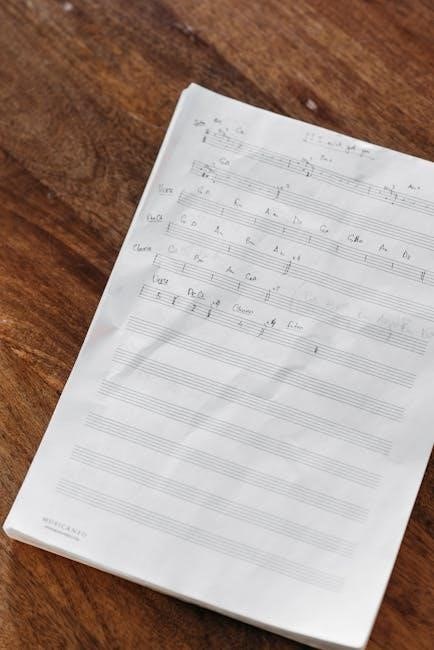
How to Download and Print the Sheet Music
Visit a trusted website, search for the Moonlight Sonata, select the desired arrangement, and download the PDF. Ensure compatibility with your printer for clear output.
5.1 Step-by-Step Guide
To download and print Moonlight Sonata sheet music in PDF, visit a reputable site like IMSLP or MuseScore. Search for “Moonlight Sonata” and select a public domain version. Click the download link and choose PDF format. Ensure your device has a PDF reader for viewing. For printing, adjust settings to fit your paper size and orientation. Preview the document to confirm layout and content accuracy. Avoid suspicious sites requesting personal info. Once printed, you’re ready to play Beethoven’s masterpiece.
5.2 Recommended Websites
For accessing free Moonlight Sonata sheet music in PDF, consider visiting reputable sites like IMSLP or MuseScore. These platforms offer high-quality, public domain scores. Additionally, Musicnotes and Piano Society provide reliable downloads, often with multiple arrangements. Always opt for public domain versions to ensure free access and avoid copyright restrictions. These websites are trusted sources for classical music enthusiasts and pianists.
5.3 MIDI Files and PDF Conversion
For those seeking flexibility, MIDI files of the Moonlight Sonata can be converted to PDF sheet music using tools like MuseScore or NoteFlight. These programs allow users to import MIDI files and export them as printable PDFs. Websites such as ClassicFM or Piano Nanny often provide MIDI downloads. While this method ensures customization, it may lack the precision of professionally typeset scores. Always verify the quality of the MIDI file before conversion for optimal results.

The Importance of Using High-Quality Sheet Music
High-quality sheet music ensures accuracy, clarity, and proper formatting, essential for learning and performing the Moonlight Sonata. It prevents errors and enhances musical interpretation and execution.
6.1 Accuracy and Clarity
High-quality sheet music ensures the Moonlight Sonata is represented accurately, with clear notation and proper formatting. This avoids confusion and errors in performance. Free PDFs from reliable sources maintain the integrity of Beethoven’s composition, preserving dynamics, articulation, and tempo markings. Clear layouts prevent misreading notes, while accurate transcriptions ensure fidelity to the original work. This is crucial for mastering the sonata’s intricate passages and emotional depth. Poor-quality sheet music can lead to mistakes, making practice frustrating and unproductive for pianists. Reliable sources guarantee a seamless learning experience.
6.2 Proper Formatting and Layout
Proper formatting and layout in free Moonlight Sonata sheet music PDFs are essential for readability and ease of performance. Well-organized scores ensure that notes, dynamics, and articulations are clearly visible, reducing eye strain and cognitive load. Consistent font sizes, proper spacing between notes, and logical page turns enhance the overall usability of the sheet music. High-quality layouts preserve the composer’s intent, making it easier for pianists to interpret and play the piece accurately. Reliable sources prioritize these aspects, ensuring a seamless musical experience for both professionals and amateur musicians.
6.3 Avoiding Common Mistakes
When using free Moonlight Sonata sheet music PDFs, avoid common mistakes like missing dynamics, incorrect tempo markings, or misaligned notes. Ensure the score is free from formatting errors, such as misplaced accidentals or incomplete measures. Cross-check with reliable sources to verify accuracy. Pay attention to page layout issues, such as overlapping notes or unclear pedaling marks. Using poorly edited sheet music can lead to performance errors and misinterpretation of Beethoven’s intent. Prioritize sources with clear, professional formatting to enhance accuracy and musicality.
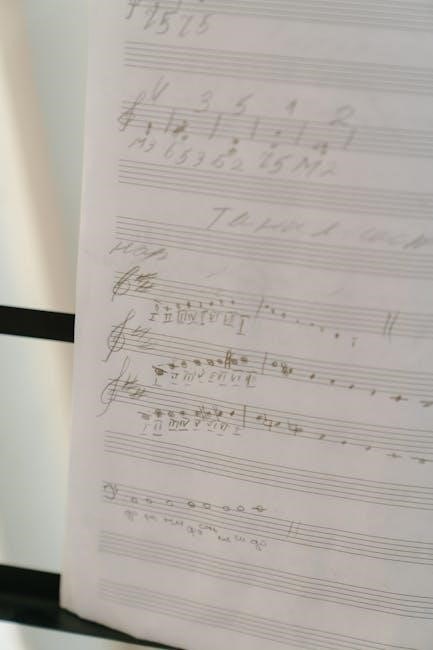
Tips for Playing the Moonlight Sonata
Mastering the Moonlight Sonata requires patience and dedication. Start with a steady tempo in the first movement, emphasizing dynamic contrasts. Practice pedaling techniques meticulously to maintain the dreamy, ethereal quality. Break challenging sections into smaller parts and gradually build fluency. Focus on phrasing and emotional expression to capture Beethoven’s intent. Regular practice and attentive listening will refine your interpretation and enhance performance quality.
7.1 Practice Techniques
Effective practice begins with breaking the sonata into manageable sections. Focus on mastering small passages before combining them. Use a metronome to maintain consistent tempo, especially in the first movement. Practice hands separately to build finger independence and dexterity. Emphasize dynamic contrasts and phrasing to capture the emotional depth. Incorporate slow practice to refine tricky arpeggios and runs. Regularly review recordings of professional pianists to gain insights and refine your interpretation. Consistent, focused practice ensures progress and mastery of this iconic piece.
7.2 Understanding Tempo and Dynamics
Mastering tempo and dynamics is crucial for a nuanced performance. The first movement, marked Adagio sostenuto, requires a slow, reflective tempo with subtle dynamic shifts. Beethoven’s indications, such as pianissimo and crescendo, guide emotional expression. The second movement, Allegretto, demands a lively yet controlled pace. Dynamics here create contrast, with sudden shifts from soft to loud. In the third movement, Presto agitato, maintain a brisk tempo while balancing dramatic dynamic changes. Staying true to Beethoven’s markings ensures the sonata’s emotional depth shines through, making it a compelling experience for both player and listener.
7.3 Pedaling Techniques
Pedaling is essential for achieving the Moonlight Sonata’s signature sound. Use the sustain pedal to create a dreamy, resonant effect in the first movement, but release it before each note to avoid muddiness. Beethoven marked the pedal with an unequals sign, indicating it should be lifted before playing the next note. In the second movement, use lighter pedaling to maintain clarity. For the third movement, apply the sustain pedal sparingly to preserve rhythmic precision. The sostenuto pedal can highlight treble melodies while keeping bass lines clear, enhancing the sonata’s dramatic contrasts and emotional depth.
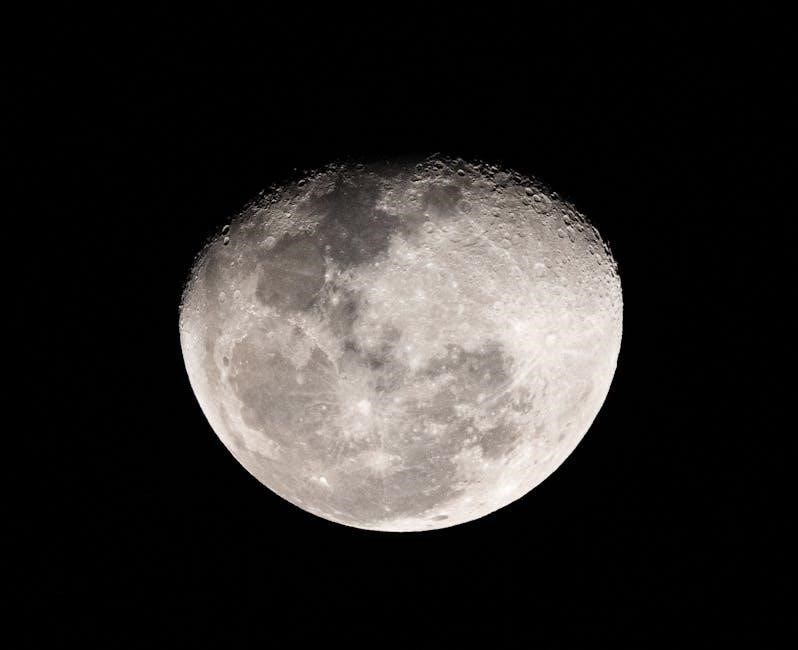
Challenges in Playing the Moonlight Sonata
Mastering the Moonlight Sonata demands precise technique, emotional depth, and interpretative skill. Pianists face challenges with delicate pedaling, rapid arpeggios, and maintaining a balanced, expressive sound throughout.
8.1 Technical Difficulties
The Moonlight Sonata presents significant technical challenges, particularly in its intricate fingerings and hand positioning. The first movement requires delicate pedaling to maintain clarity, while the third movement demands exceptional dexterity for rapid arpeggios and scales. Pianists must master precise control to avoid muddying the left-hand arpeggios in the opening and handle the demanding passages in the finale with accuracy. These technical demands make the piece accessible only to advanced pianists who have dedicated substantial time to practice and refinement of their skills.
8.2 Musical Interpretation
Musical interpretation of the Moonlight Sonata requires a deep understanding of Beethoven’s emotional intent. The piece demands nuanced tempo modifications, dynamic contrasts, and expressive phrasing. Pianists must balance the dreamy, lyrical qualities of the first movement with the vibrant energy of the second and the dramatic intensity of the third. Effective interpretation hinges on subtle pedaling techniques and a strong connection to the music’s emotional core, ensuring a compelling performance that resonates with listeners on a profound level.
8.4 Performance Anxiety
Performance anxiety when playing the Moonlight Sonata is common due to its technical and emotional demands. Pianists may feel pressure to flawlessly execute the piece, especially given its popularity and cultural significance. Anxiety can manifest as trembling hands, memory lapses, or rushed tempos. To combat this, focused practice, mental preparation, and a mindset shift from perfectionism to musical expression are essential. Embracing the music’s emotional depth and connecting with the audience can help alleviate nerves and deliver a compelling performance.
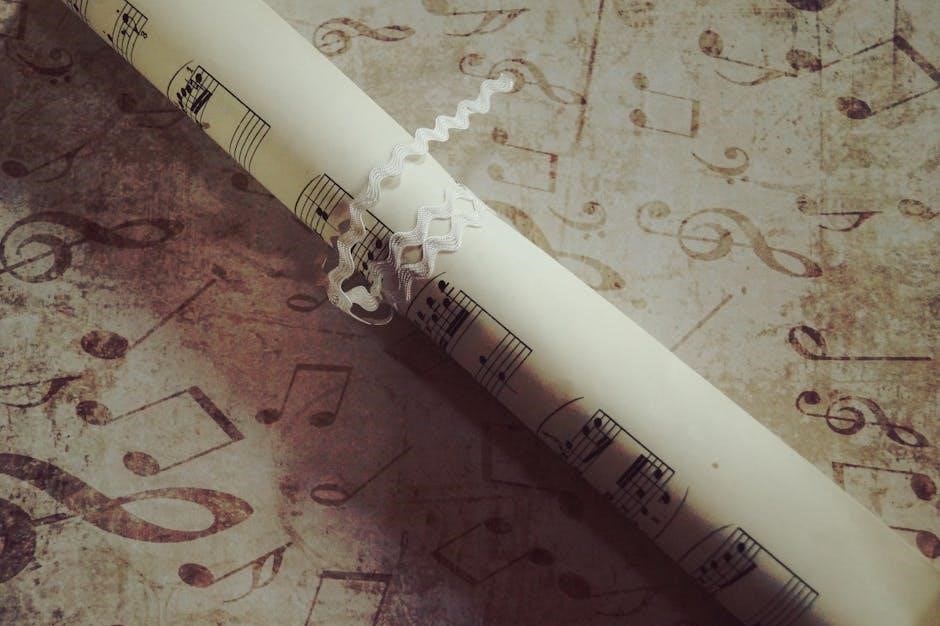
The Moonlight Sonata in Popular Culture
The Moonlight Sonata is widely featured in films, TV shows, and commercials, enhancing emotional scenes with its haunting beauty. Its familiarity makes it a popular choice for public performances and modern arrangements, further cementing its cultural impact and enduring appeal across generations.
9.1 Film and Media Appearances
The Moonlight Sonata has been extensively featured in films, TV shows, and commercials, leveraging its emotional depth to enhance dramatic scenes. Its iconic melody appears in movies like The Pianist and Atonement, as well as in numerous advertisements, making it instantly recognizable. The piece’s haunting beauty and familiarity have made it a staple in media, further solidifying its cultural significance. This widespread use has also driven interest in accessing free sheet music, particularly in PDF format, as musicians and enthusiasts seek to play and interpret the sonata themselves.
9.2 Covers and Remixes
The Moonlight Sonata has inspired countless covers and remixes across various genres, from classical to electronic and rock. Artists like Brian Eno and The Beatles have reinterpreted its melody, while modern producers incorporate it into trance and lo-fi tracks. These adaptations introduce the sonata to new audiences, sparking interest in its original composition. As a result, many seek free sheet music in PDF format to explore and play these creative renditions, blending tradition with contemporary styles.
9.4 Cultural Impact
The Moonlight Sonata’s emotional depth has made it a cultural icon, symbolizing romance and introspection. Its presence in films, advertisements, and popular media has cemented its place in global culture. The ease of finding free sheet music PDFs has allowed pianists of all levels to engage with the piece, furthering its reach and influence. This accessibility ensures that Beethoven’s masterpiece remains a cornerstone of musical culture, continuing to inspire new generations of musicians and audiences alike.

Legal Aspects of Free Sheet Music
Beethoven’s Moonlight Sonata is in the public domain, making free sheet music legal. Copyright laws vary globally, but public domain works are freely accessible. Always verify sources.
10.1 Copyright Laws
Copyright laws protect intellectual property, but Beethoven’s Moonlight Sonata is in the public domain. Since the composer’s works are no longer under copyright, the sheet music can be freely downloaded and shared without legal repercussions. This applies worldwide, as copyright expiration is based on the composer’s death. However, specific arrangements or editions may still be copyrighted. Always verify the source to ensure compliance with local laws. Public domain status makes the Moonlight Sonata widely accessible for free, promoting its global appreciation and educational use.
10.2 Public Domain Works
Beethoven’s Moonlight Sonata is in the public domain, meaning its original composition is freely accessible without copyright restrictions. This allows the sheet music to be legally downloaded and shared in PDF format. Since the work is centuries old, no permission is required to use or distribute it. However, specific arrangements or transcriptions may still be copyrighted. Always verify the source to ensure the version you use is in the public domain. This accessibility has made the Moonlight Sonata a staple in educational and cultural resources worldwide.
10.3 Fair Use and Licensing
Fair use principles allow limited use of copyrighted material without permission, but this applies differently to the Moonlight Sonata. Since Beethoven’s original work is in the public domain, licensing isn’t required for the composition itself. However, specific editions or arrangements may be copyrighted, requiring permission or licensing. Always verify if a particular version is under copyright. Sharing or using copyrighted works without proper authorization can lead to legal consequences. Ensure you respect licensing terms to avoid infringement, even for free sheet music downloads.

Resources for Further Learning
Explore tutorials, video lessons, and communities for mastering the Moonlight Sonata. Online forums and discussions offer insights and tips from experienced pianists and educators.
11.1 Tutorials and Video Lessons
Video lessons and tutorials are excellent resources for mastering the Moonlight Sonata. Platforms like YouTube and MasterClass offer detailed breakdowns of each movement, focusing on technique and interpretation. Many pianists share their insights, covering aspects like finger placement, tempo control, and emotional expression. These lessons often complement sheet music, providing visual and auditory guidance for complex passages. Additionally, websites dedicated to classical music education host tutorials specifically for Beethoven’s works, making learning more accessible and engaging for pianists of all levels.
11.2 Sheet Music Communities
Sheet music communities are invaluable for finding free Moonlight Sonata PDFs. These platforms host extensive libraries, often including user-shared transcriptions and arrangements. Members collaborate, sharing insights and tips for mastering the piece. Discussions about interpretations and technical challenges are common, fostering a supportive environment for pianists. Many communities offer multiple versions of the sonata, catering to different skill levels and styles. Additionally, forums within these communities can provide recommendations for reliable sources of high-quality sheet music.
11.3 Online Forums and Discussions
Online forums and discussions are excellent resources for pianists seeking Moonlight Sonata sheet music; These platforms offer tips, advice, and recommendations from experienced musicians. Users often share their interpretations and challenges, fostering a collaborative environment. Discussions frequently include links to free PDF downloads and insights into performance techniques. Additionally, forums provide a space to ask questions and receive feedback, helping pianists refine their skills. Engaging with these communities can also offer historical context and deeper understanding of the sonata’s composition.
The Moonlight Sonata remains a beloved piece, with free sheet music readily available. Prioritize quality sources for accuracy and expression, inspiring both novice and advanced pianists.
12.1 Recap of Key Points
The Moonlight Sonata sheet music PDF can be freely downloaded from reliable platforms like the International Music Score Library Project or MuseScore. Ensure the scores are in the public domain to avoid copyright issues. High-quality sheet music is essential for clarity and accurate interpretation. Pianists should practice meticulously, focusing on tempo and pedaling techniques. The sonata’s emotional depth and technical challenges make it a rewarding piece to master. Exploring tutorials and online communities can further enhance your learning experience.
12.2 Final Thoughts
The Moonlight Sonata remains a timeless masterpiece, with its sheet music widely available for free in PDF format. Leveraging reliable sources ensures access to high-quality scores, aiding pianists in mastering this iconic piece. The sonata’s emotional and technical depth offers a rewarding experience for musicians of all levels. Embrace the journey of learning and performing this beloved composition, and explore its cultural significance through free resources. Let the Moonlight Sonata inspire your musical endeavors and deepen your appreciation for classical music.

Write Reviews
Leave a Comment
No Comments & Reviews